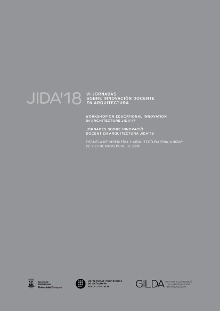Aprendizaje colaborativo y multidisciplinar en el estudio del Patrimonio en Arquitectura
DOI:
https://doi.org/10.5821/jida.2018.5490Resumen
La presente comunicación pretende subrayar la necesidad de incorporar dinámicas de aprendizaje colaborativo mediante la transversalidad y la multidisciplinareidad al estudio del Patrimonio arquitectónico y urbanístico. Se expone una manera de afrontarlo abordada desde 2014 hasta la actualidad en la Escuela Técnica Superior de Arquitectura de Valladolid estructurada como un Proyecto de Innovación Docente universitario. La mejora del aprendizaje entre los futuros arquitectos se ha visto mejorada gracias a las aportaciones recibidas desde diferentes ámbitos disciplinares convergentes en el tema del Patrimonio (geógrafos, arqueólogos, urbanistas e historiadores, además de arquitectos), y a la puesta en práctica de múltiples actividades compartidas con estudiantes de otras universidades enfocadas a resolver problemáticas concretas del entorno regional en conexión directa con la ciudadanía local. Uno de ellos, un seminario recientemente desarrollado en Grajal de Campos, se expondrá como ejemplo de transversalidad e interdisciplinariedad en forma de taller donde prima el aprendizaje colaborativo.Citas
ALMONACID, Rodrigo (2017): “Innovación docente en Arquitectura para la generación millennialâ€. En: GarcÃa Escudero, Daniel; Bardà i Milà , Berta (eds.): JIDA 4. Textos de Arquitectura, Docencia e Innovación. Barcelona: Iniciativa Digital Politécnica - UPC; GILDA, pp. 36-41.
BRUFFEE, Kenneth A. (1993): Collaborative Learning: Higher Education, Interdependence, and the Authority of Knowledge. Baltimore (USA): Johns Hopkins University Press.
CASTILLA-CABANES, Nuria (2017): “El trabajo en equipo en la docencia de la arquitecturaâ€. En: GarcÃa Escudero, Daniel; Bardà i Milà , Berta (eds.): JIDA 4. Textos de Arquitectura, Docencia e Innovación. Barcelona: Iniciativa Digital Politécnica - UPC; GILDA, pp. 42-49.
CARBONELL, Elena, RICO, Daniel y ROVIRA, Joan (2009): “Hominem quaero. Sin noticia de las Humanidadesâ€. En: DE LA MOTA, Carme y PUIGVERT, Gemma (eds.): La investigación en Humanidades. Madrid, pp. 299-312.
CARERI, Francesco (2002): Walkscapes. El andar como práctica estética. Barcelona: Gustavo Gili.
DOCHY, Filip, SEGERS, Mien R. y SLUIJSMANS, Dominique (1999): “The use of self-, peer- and co-assessment in higher education. A review of literatureâ€. Studies in Higher Education, vol. 4, nº3, pp. 331-350. https://doi.org/10.1080/03075079912331379935
DRUCKER, Peter F. (2002): The discipline of innovation. Boston: Harvard Business Review.
GABELICA, Catherine, VAN DEN BOSSCHE, Piet, DE MAEYER, Sven, SEGERS, Mien R. y GIJSELAERS, Wim (2014): “The effect of feedback and guided reflexivity on team performance changeâ€. Learning and Instructions, vol.34, pp. 86-96. https://doi.org/10.1016/j.learninstruc.2014.09.001
GARCÃA CUETOS, MarÃa Pilar (2011): El patrimonio cultural. Conceptos básicos. Zaragoza: Universidad de Zaragoza, pp. 89-118.
HAMLYN-HARRIS, James H., HURST, Barbara J., VON BAGGO, Karola, and BAYLEY, Anthony J. (2006): “Predictors of team work satisfactionâ€. Journal of information Technology Education, vol. 5, pp. 299-315.
HINSZ, Verlin B., TINDALE, R. Scott y VOLLRATH, David A. (1997): “The Emerging Conceptualization of Groups as Information Processorsâ€. Psychological Bulletin, vol. 121, nº1, pp. 43-64.
MASDÉU, Marta (2016): “La enseñanza de la arquitectura en la sociedad actual. La integración de las nuevas formas de práctica profesional en el Taller de Arquitecturaâ€, Revista Indexada de Textos Académicos _rita, nº5, pp. 72-79.
OAKLEY, Barbara, FELDER, Richard M., BRENT, Rebecca y ELHAJJ, Imad H. (2004): “Turning student groups into effective teamsâ€. Journal of Student Centered Learning, vol. 2, nº1, pp. 9-34.
PÉREZ GIL, Javier: “Arquitectura y Patrimonio: nuevos paradigmas conceptuales y docentesâ€, Revista Electrónica Interuniversitaria de Formación del Profesorado (REIFOP), nº 2 (2013), pp. 163-174. DOI: http://dx.doi.org/10.6018/reifop.16.2.180781
PÉREZ, Javier, SANTOS, Luis, ALMONACID, Rodrigo, LALANA, José Luis, JIMENO, Vanessa y GARCÃA, JoaquÃn (2016): “Interdisciplinarity in Architecture: towards a genuine cross-disciplinary educationâ€, EDULEARN16 Proceedings. 8th International Conference on Education and New Learning Technologies, IATED Academy, pp. 6362-6367.
PFAFF, Elisabeth, y HUDDLESTON, Patricia (2003): “Does it matter if I hate teamwork? What impacts students attitudes towards Teamwork", Journal of Marketing Education, vol. 1, nº 25, pp. 37-45. https://doi.org/10.1177/0273475302250571
TUCKER, Richard y ABBASI, Neda (2015): “The architecture of teamwork: examining relationships between teaching, assessment, student learning and satisfaction with creative design outcomesâ€. Journal of Architectural Engineering and Design Management, vol. 15, nº6, pp. 405-422.



















